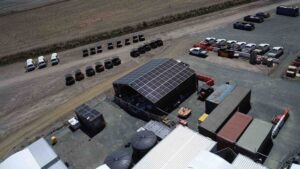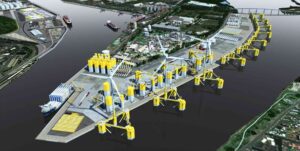Australia’s first offshore wind project, the Star of the South, has narrowed down a route for the overland – but underground – transmission line that would connect the proposed 2,000MW of wind generation capacity to the grid in Victoria.
The Star of the South, which is owned by its Australian founders and Copenhagen Infrastructure Partners (CIP), said the milestone decision had followed a rigorous 12-month assessment of three potential transmission route options connecting the offshore wind project, proposed for development off the south coast of Gippsland.
The project’s developers said the selected route, which would now be progressed through detailed planning, approvals and design processes, proposed to come to shore around Reeves Beach and travel underground through Darriman, Giffard West and Hiamdale.
The transmission line would then connect to the National Electricity Market at one of the grid’s “strongest points,” either at the site of the former Hazelwood coal power plant in Victoria’s Latrobe Valley, or at the site of AGL Energy’s Loy Yang power station.
“This is another important milestone for Australia’s first offshore wind project – selecting a transmission route to take through planning, approvals and design,” said Star of the South chief development officer, Erin Coldham.
“Star of the South would harness Gippsland’s strong offshore winds in Bass Strait – powering homes into the future and creating long-term local jobs for the region.”
Notably, the developers stressed that the Star of the South had committed to using underground cables for the transmission line, unless it was deemed not technically feasible or that overhead lines would have a lower impact.
This move could put the massive project on the front foot with local communities, at a time when major grid infrastructure upgrades – and in particular massive new transmission lines – are becoming the latest battle front in the shift to renewables.
In Victoria’s west, community groups are pushing back against AusNet Services plans for the Western Victoria Transmission Network Project, the latest design for which proposes a transmission line stretching nearly 200km from Bulgana to the north-western Melbourne suburb of Sydenham.
In that case, a coalition of local landowners, residents and businesses that calls itself Stop AusNet’s Towers has called on governments to guarantee “full, genuine consultation, conduct and independent analysis” of alternatives to overhead lines, including underground options.
Similar issues are developing in NSW, over works to accommodate the Snowy 2.0 scheme, and in north-western Tasmania, where major grid upgrades are being planned around big new wind farms and a proposed second interconnector between Tasmania and the mainland.
Nonetheless, the underground transmission line proposed for the 2GW Star of the South would still be a major undertaking, with a corridor of about 3km wide and a 40-metre easement.
In a statement, the Star of the South project team said it was continuing conversations with landholders whose property might be suitable to host the transmission infrastructure, and that landholders would be treated fairly and appropriately compensated.
“On balance, the route we’ve selected for further investigation is the best overall outcome and we’re working with landholders whose property may be suitable to host the underground cables,” said Coldham.
“We’re excited to get out and talk with people after the challenges of coronavirus and encourage everyone to come along to our events to learn more about offshore wind and what it means for Gippsland.”
The company has also weighed in on EnergyAustralia’s decision earlier this month to bring forward the closure of its Latrobe Valley Yallourn coal plant, promising to provide new opportunities to continue the region’s “proud history” of power generation.
“We will seek discussions with EnergyAustralia, the Latrobe Valley Authority and other relevant authorities on how we can work together to support workers who may be able to retrain for a future career in offshore wind,” the Star of the South said in a separate statement.
In a submission to the Australian Energy Market Operator in June of last year, the Star of the South cited modelling showing the offshore wind project had the capacity to “almost wholly, and reliably, cover the generation shortfall of a Yallourn exit and it would do so, bereft of any short-term transmission upgrade to VNI West.”
The next step for the Star of the South, the developers said, would be comprehensive coordinated government environmental assessments through an Australian Environmental Impact Statement and Victorian Environment Effects Statement.
Site investigations and data collection was also underway, the statement said, supported by some of Australia’s leading scientists and researchers from CSIRO, Monash, Deakin and Curtin universities.










